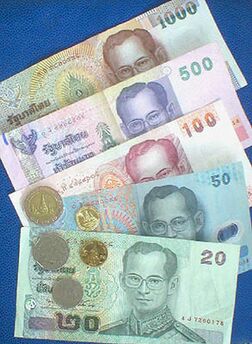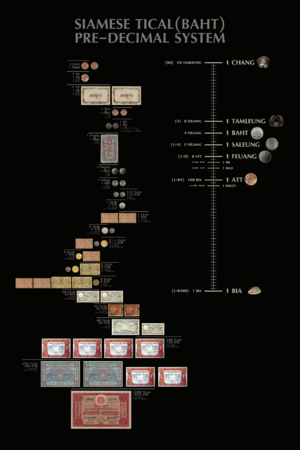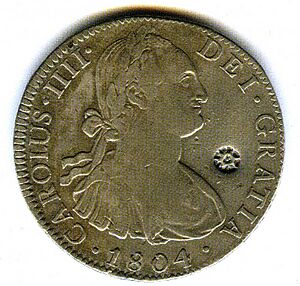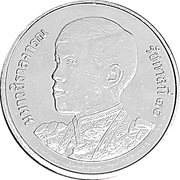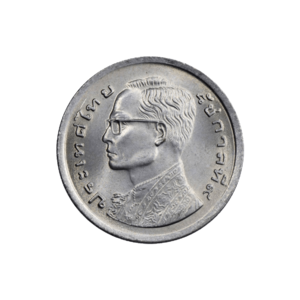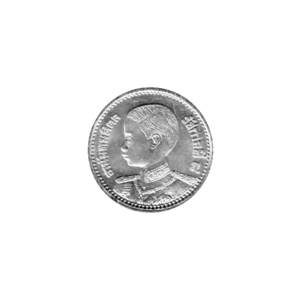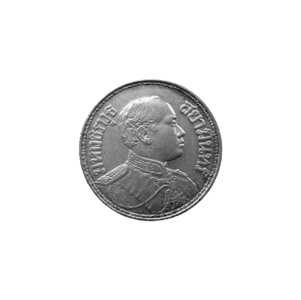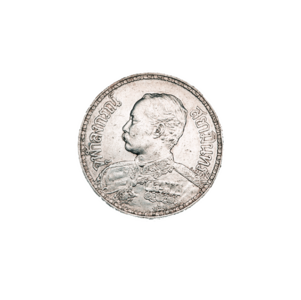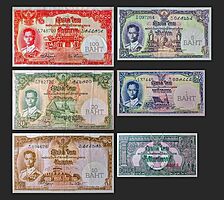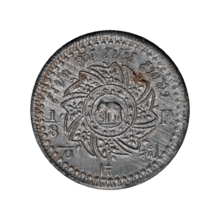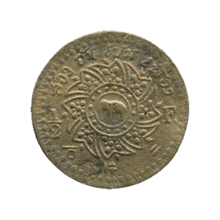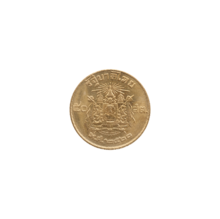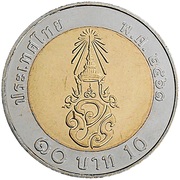Thai baht facts for kids
Quick facts for kids Thai baht |
|||
|---|---|---|---|
|
|||
| ISO 4217 Code | THB | ||
| Official user(s) | |||
| Unofficial user(s) | |||
| Inflation | 1.0% | ||
| Source | Inflation (annual %), World Bank, 2011–2015 | ||
| Subunit | |||
| 1⁄100 | satang | ||
| Symbol | ฿ | ||
| Plural | The language(s) of this currency does not have a morphological plural distinction. | ||
| Coins | |||
| Freq. used | 25, 50 satang, ฿1, ฿2, ฿5, ฿10 | ||
| Rarely used | 1, 5, 10 satang | ||
| Banknotes | |||
| Freq. used | ฿20, ฿50, ฿100, ฿500, ฿1000 | ||
| Printer | Note Printing Works of the Bank of Thailand | ||
The baht (pronounced "baht") is the official money of Thailand. It is split into 100 smaller units called satang. Before Thailand used a system based on 100 parts, the baht was divided into eight feuang, and each feuang had eight att. The Bank of Thailand is in charge of printing and issuing the baht. In December 2023, the Thai baht was ranked as the 10th most used currency for payments around the world.
Contents
History of the Thai Baht
The Thai baht, like the British pound, started as a way to measure weight. Its value was first linked to the weight of silver. One baht was equal to about 15 grams of silver. This system was used a long time ago, possibly as early as the Sukhothai Kingdom. Back then, they used special silver coins called photduang or "bullet money." These coins were made of solid silver, shaped into a circle, and had different weights.
This old system was used until 1897. That's when Prince Jayanta Mongkol and King Chulalongkorn introduced a new, simpler system. They decided that one baht would be equal to 100 satang, just like how many currencies today use 100 smaller units. Even though the new system started in 1897, some coins from the old system were still made until 1910. Today, people in Thailand still sometimes call 25 satang a salueng, which was an old unit.
For a long time, the baht's value was tied to silver. This meant its value could change compared to currencies that were tied to gold. For example, from 1856 to 1864, 5 baht was worth 3 Spanish dollars or 7 Indian rupees. Later, the baht was linked to the British pound. In 1908, 13 baht was equal to one British pound. This changed to 12 baht in 1919 and 11 baht in 1923. During World War II, the baht's value was set to be the same as the Japanese yen in 1942.
From 1956 to 1973, the baht was linked to the US dollar, with 20.8 baht equal to one dollar. Then, from 1984 to 1997, it was set at 25 baht to one dollar. But in 1997, the 1997 Asian financial crisis hit Thailand. The baht's value was allowed to "float" (meaning it wasn't fixed anymore), and it lost half its value. It reached its lowest point of 56 baht to the dollar in January 1998. By January 2021, it had recovered to about 30 baht per dollar.
Foreigners used to call the baht "tical." This name was even printed on Thai banknotes in English until 1925.
Currency Symbol and Abbreviations
The symbol for the Thai baht is ฿. It looks like a letter B with a line through it. This symbol was given a special code for computers in 1986, so it could be used easily in digital text.
How the Baht is Abbreviated
In Thailand, the word baht (บาท) is officially shortened to บ. when written. This is set by Thai law.
Bitcoin and the Baht Symbol
For a while, some people used the baht symbol (฿) for Bitcoin, which is a type of digital money called cryptocurrency. To avoid confusion, a new symbol (₿) was created for Bitcoin. It looks like a B with two lines through it.
Coins of Thailand
Early Bullet Money
Before 1860, Thailand didn't make coins using modern machines. Instead, they used "bullet" coins, which were metal bars bent into a circle with special marks stamped on them. These were called photduang.
- Sukhothai and Ayutthaya Periods: Early photduang coins from the Sukhothai period had longer "legs" and a bigger hole in the middle. They were mostly silver and had a cut to check the silver's quality. As time went on, especially during the Ayutthaya period, the coins became rounder with shorter legs, and the hole got smaller or disappeared.
- Thonburi and Rattanakosin Periods: Coins from these later periods had no central hole and even shorter legs. They usually had two stamped marks: one for the ruling family (Dynasty mark) and one for the king (personal mark). These marks helped identify coins from different times.
- Markings and Production: In the Sukhothai era, anyone could make money, so the marks varied a lot. But from the Ayutthaya period onwards, only the government made photduang. The Dynasty mark often showed a "Wheel of Law" or a Chakra. The king's personal mark changed with each ruler, using symbols like a conch shell or a Garuda bird.
Bullet Money Timeline
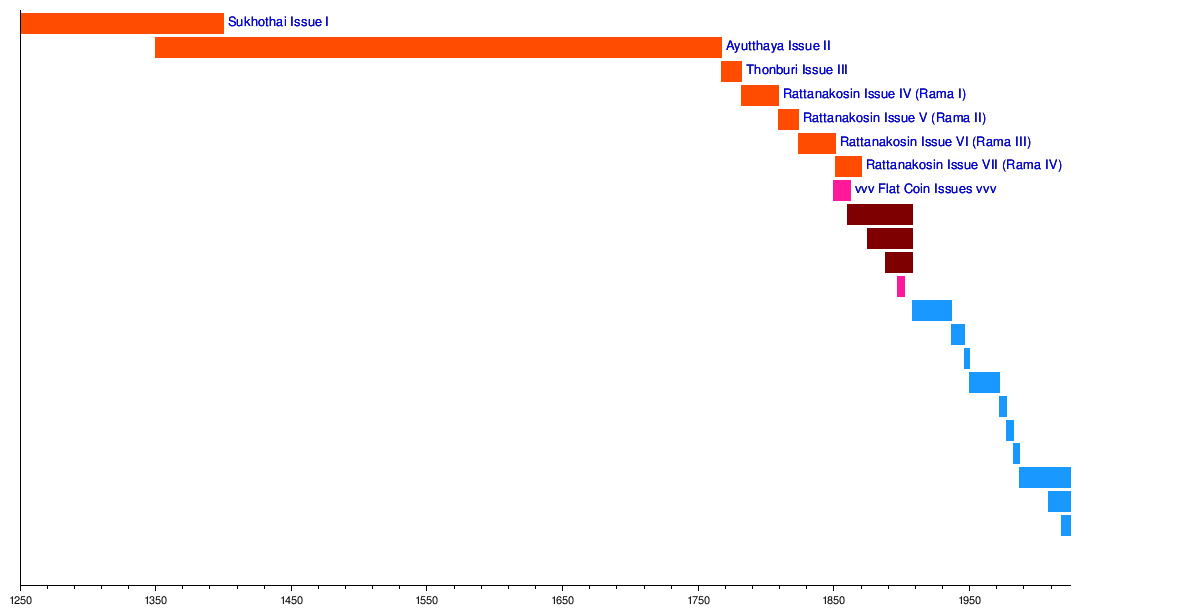
*continues in the coin section*
Modern Coins (Pre-Decimal)
King Rama III (1824–1851) was the first to think about using flat, round coins. He was worried about the creatures killed to get cowrie shells, which were used as small money. In 1860, Thailand started making modern-style coins. These included silver coins like 1 and 2 salung, and 1, 2, and 4 baht. Tin coins (1 solot, 1 att) came in 1862, and gold coins (2.5, 4, 8 baht) in 1863. Copper coins replaced tin for some smaller values in 1874. The last gold coins were made in 1895.
Coin Timeline
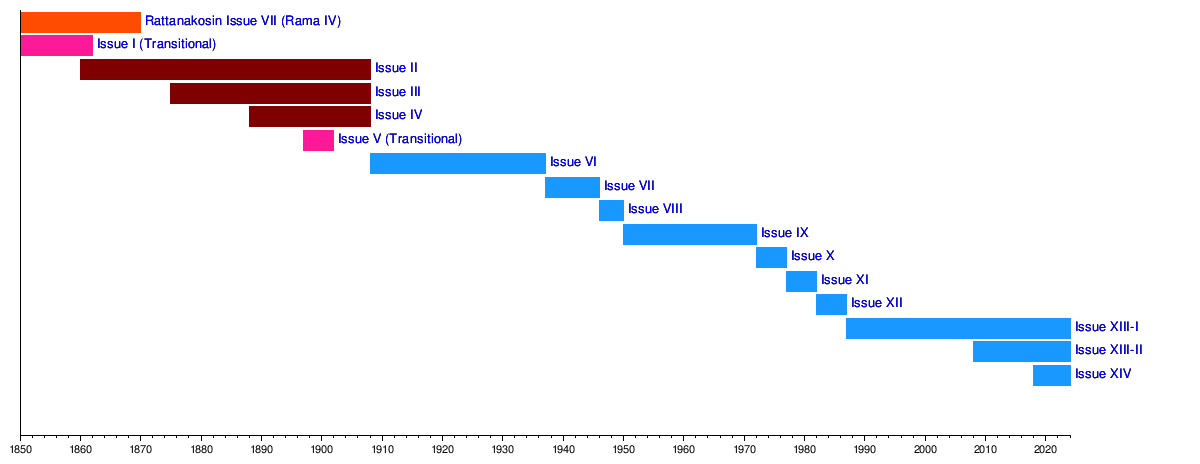
Decimal Coins
The idea of changing the Thai baht to a decimal system (where 1 baht = 100 satang) came at the end of the 1800s. The Minister of Treasury, Jayanta Mongkol, thought it would make counting money easier and help modernize Thailand.
The first coins with "satang" on them were made in 1897. These were 2.5, 5, 10, and 20 satang coins. However, some older unit coins were still made for a few more years. In 1908, new 1, 5, and 10 satang coins with holes in the middle were introduced. The 1 and 2 salung coins were replaced by 25 and 50 satang coins in 1915.
During World War II, there was a shortage of nickel, so silver coins for 5, 10, and 20 satang were made in 1941. The next year, tin coins were used for 1, 5, and 10 satang. In 1950, coins made of a mix of aluminum and bronze were introduced for 5, 10, 25, and 50 satang.
New 1-baht coins made of a copper-nickel mix came out in 1962. In 1972, 5-baht coins were introduced. Between 1986 and 1988, a whole new set of coins was made, using different metals like aluminum for small satang coins, and two different metals for the 10-baht coin. In 2005, 2-baht coins made of nickel-plated steel were introduced.
Current Coins
The coins used today are part of the 14th series. In 2008, the Thai government announced changes to the coins to save money on production. For example, the 2-baht coin, which looked a lot like the 1-baht coin, was changed from nickel-plated steel to aluminum bronze to make it easier to tell apart. These new coins were released in 2009.
In 2018, new coins were issued with a portrait of the current king, Maha Vajiralongkorn. These coins have the same sizes and weights as the previous ones.
Important Notes About Coins
- The 1, 5, and 10 satang coins are mostly used by banks and are not usually seen in everyday shopping.
- Older coins only had Thai numbers, but newer coins have both Thai and regular (Arabic) numbers.
- The 10-baht coin has special raised dots on the back that are like Braille for the number 10.
- 10-baht coins are very similar in size and weight to 2-euro coins. Sometimes, vending machines that aren't updated might mistake them for 2-euro coins, even though they are worth much less.
- Many special 1-, 2-, 5-, and 10-baht coins have been made to celebrate important events. There are also special 20-, 50-, and 100-baht metal coins, and even more valuable coins made of precious metals.
In 2010, the Treasury Department of Thailand said they were planning a new 20-baht coin for everyday use.
Monarch's Profile on Coins
Banknotes of Thailand
The first government notes were issued in 1851. These early notes had values like 1 tical and up to 10 tamlueng. After 1857, notes for 20 and 40 ticals were issued, also showing their value in other currencies like the Straits dollar and Indian rupee.
In 1892, the treasury printed notes for 1, 5, 10, 40, 80, 100, 400, and 800 ticals. The Thai text on these notes already called them "baht."
On September 19, 1902, the government started issuing notes printed by a British company called Thomas De La Rue & Company Limited. These notes came in values of 5, 10, 20, 100, and 1000 ticals (baht in Thai). Later, 1 and 50 tical notes were added in 1918. In 1925, new notes were issued with values of 1, 5, 10, 20, 100, and 1,000 baht. These notes had numbers in both Arabic and Thai, but no English text. English speakers still called them "ticals."
On July 27, 2010, the Bank of Thailand announced that new banknotes (the 16th series) would be released in December 2010. On August 9, 2012, an 80-baht banknote was issued to celebrate Queen Sirikit's 80th birthday. This was the first Thai banknote to use a special security thread.
In 2017, the Bank of Thailand released a new set of banknotes to honor the late King Bhumibol Adulyadej (Rama IX). These notes were the same size as the previous ones, but their back designs showed pictures from the king's life. These new banknotes were issued on September 20.
In 2018, the Bank of Thailand introduced a new set of banknotes featuring a portrait of the current king, Maha Vajiralongkorn. The colors and sizes are the same as before. The back designs show images of past Thai kings. The 20, 50, and 100 baht notes were released on April 6, 2018, and the 500 and 1,000 baht notes on July 28, 2018.
Banknote Timeline
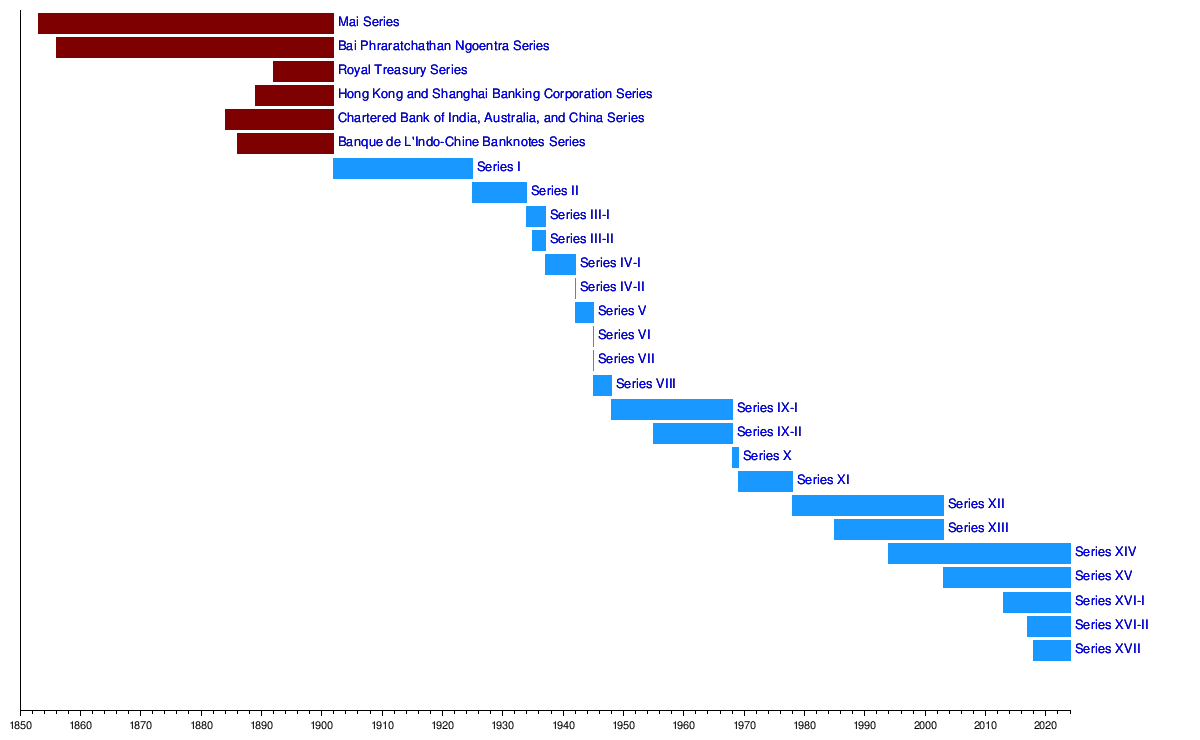
Banknotes from 1948 to Today
Banknotes from Series 9 to Series 13 are still technically legal to use, but you won't see them in everyday shopping anymore.
Series 9 Banknotes (1948-1969)
These banknotes were printed by Thomas De La Rue & Company Limited. There were two versions, one with a younger portrait of the king and one with a newer portrait. The colors used in this series became the standard colors for all future banknote series because they were used for about 20 years.
Series 10 Banknotes (1968-1969)
This series was also printed by Thomas De La Rue & Company Limited. Only the 100-baht note was issued in this series. It was made to replace the Series 9 100-baht note because of many fake notes being made.
Series 11 Banknotes (1969-1978)
In this series, the 500-baht note was introduced for the very first time. This happened as the Bank of Thailand started printing its own money. Because of this, the 1-baht note was no longer produced.
Series 12 & 13 Banknotes (1978-2003)
These series were made to honor past Thai kings and were called "The Great Series" by the Bank of Thailand. The 5-baht note was no longer produced. The 50-baht and 500-baht notes in Series 13 were released to celebrate Bangkok's 200th birthday in 1982.
Series 14 Banknotes (1992-2005)
The 14th series of banknotes focused on the work of the Chakri Kings. Three official notes were issued, but a polymer 50-baht note was also produced.
Series 15 Banknotes (2001-2005)
Series 15 updated the designs from Series 14. The 1000-baht note was made smaller. There were two versions of this series, with the second one having better security features.
Series 16 Banknotes (2012-2017)
Like Series 15, Series 16 banknotes updated the design to show a more recent picture of King Bhumibol Adulyadej (Rama IX). There were two versions: the later one was a special commemorative series released for a year after King Rama IX passed away. This special Series 16-2 showed the life and achievements of King Rama IX on the back.
Series 17 Banknotes (2018-Present)
The 17th series of banknotes features a portrait of the current king, Maha Vajiralongkorn. The colors and sizes of the notes are the same as before. The back designs show pictures of the Kings of Thailand from the past to the present. The 20, 50, and 100 baht notes were released on April 6, 2018. The 500 and 1,000 baht notes were released on July 28, 2018.
Money and Weight
The Thai word Ngoen ({{wikt:เงิน|เงิน}}) means both "silver" and "money" in general. This shows that the baht was first a unit of weight for precious metals and gemstones. One baht is equal to 15.244 grams. For pure Thai gold, which is usually 96.5 percent pure, one baht of gold actually weighs about 14.71 grams. For jewellery, one baht of gold should weigh more than 15.16 grams.
Historical Coin Materials
| Example Coin | Material | Date in Use | Denomination Minted |
|---|---|---|---|
| Gold | 1863-1905*
*These coins were only minted in 1863 & 1876, but they were officially stopped when the decimal system started. |
Pre-Decimal Coins
|
|
| Silver | 1860-1962 | Pre-Decimal Coins
Decimal Coins
|
|
| Tin | 1860-1950 | Pre-Decimal Coins
Decimal Coins
|
|
| Copper | 1865 - 1905 | Pre-Decimal Coins
|
|
| Brass | 1865-1977 | Pre-Decimal Coins
Decimal Coins
|
|
| Bronze | 1887-1957 | Pre-Decimal Coins
Decimal Coins
|
|
| Nickel | 1908-1937 | Decimal Coins
|
|
| Aluminium-Bronze | 1950-present | Decimal Coins
|
|
| Cupronickel | 1897-present | Transitional Coins (1897-1905)
Decimal Coins
|
|
| Nickel-Plated Steel | 2005-present | Decimal Coins
|
|
| *inner part | Copper-Aluminium-Nickel | 2008-present | Decimal Coins
|
| *no wiki-image exist a Al-Br coin version is used | Copper-Plated Steel | 2008-present | Decimal Coins
|
| This table only includes modern, flat coins. Older bullet coins and other types are not included. | |||
Exchange Rates
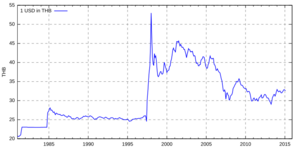
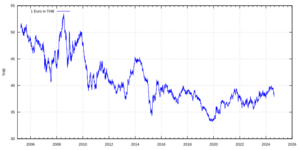
On December 19, 2006, the Bank of Thailand put in place some rules about exchanging money. This caused the exchange rates inside and outside Thailand to be very different. However, most of these rules were removed by March 3, 2008, so now the exchange rates are usually the same everywhere.
| 2000 | 2001 | 2002 | 2003 | 2004 | 2005 | 2006 | 2007 | 2008 | 2009 |
| 40.24 | 40.26 | 37.92 | 32.34 | 32.99 | 34.34 | 31.73 | 30.48 | 31.07 | 30.71 |
| 2010 | 2011 | 2012 | 2013 | 2014 | 2015 | 2016 | 2017 | 2018 | 2019 |
| 32.48 | 34.25 | 35.28 | 33.91 | 32.48 | 34.25 | 35.30 | 33.94 | 32.31 | 31.05 |
| 2020 | 2021 | 2022 | 2023 | 2024 | 2025 | 2026 | 2027 | 2028 | 2029 |
| 31.30 |
(Source 1999–2013: usd.fx-exchange.com)
(Source 2014–2020: Bank of Thailand) [1]
| Current THB exchange rates | |
|---|---|
| From Google Finance: | AUD CAD CHF EUR GBP HKD JPY USD INR TWD |
| From Yahoo! Finance: | AUD CAD CHF EUR GBP HKD JPY USD INR TWD |
| From XE.com: | AUD CAD CHF EUR GBP HKD JPY USD INR TWD |
| From OANDA: | AUD CAD CHF EUR GBP HKD JPY USD INR TWD |
| From fxtop.com: | AUD CAD CHF EUR GBP HKD JPY USD INR TWD |
See also
- Economy of Thailand
- Stock Exchange of Thailand


